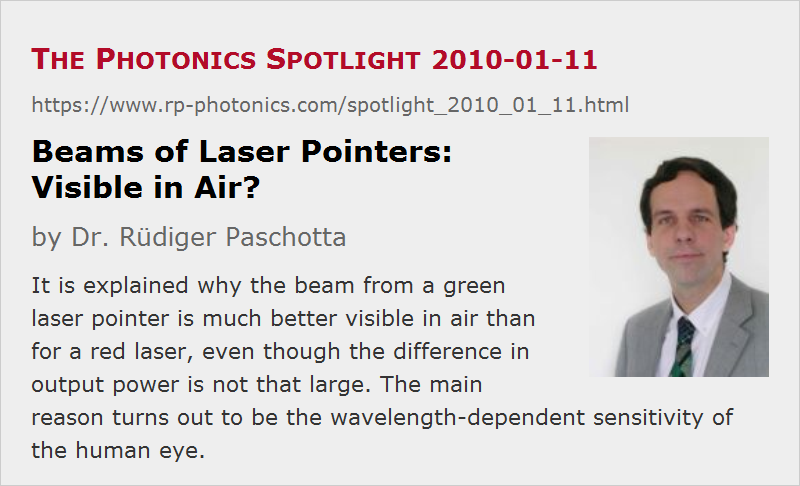Beams of Laser Pointers: Visible in Air?
Posted on 2010-01-11 as a part of the Photonics Spotlight (available as e-mail newsletter!)
Permanent link: https://www.rp-photonics.com/spotlight_2010_01_11.html
Author: Dr. Rüdiger Paschotta, RP Photonics Consulting GmbH
Abstract: It is explained why the beam from a green laser pointer is much better visible in air than for a red laser, even though the difference in output power is not that large. The main reason turns out to be the wavelength-dependent sensitivity of the human eye.

Ref.: encyclopedia articles on laser pointers, laser beams; article on luminosity functions
I have two laser pointers: a small red one, and a larger green one (see the figure).

When I take the green laser and shoot into the night sky, I very clearly see the beam in the air over a large distance. When I do that with the red laser, however, hardly anything is seen.
There are three reasons for that remarkable difference:
- The green laser has a few milliwatts, the red one only about 1 mW.
- The beam is visible in air only due to scattering. In clean air, that is Rayleigh scattering, the strength of which scales with the inverse fourth power of the wavelength. This means that the difference in scattering efficiency between 530 nm and 670 nm is a factor of 2.6.
- The human eye is much more sensitive to the green light (around 530 nm) than for the red light (670 nm). Interestingly, the difference in sensitivity depends strongly on the overall brightness of the scene. Under normal daylight conditions, one has to use the photopic sensitivity curve, which tells us that the sensitivity at 530 nm is roughly 20 times higher than at 670 nm. With the eye adapted to the dark night, however, that difference becomes much stronger. The reason for this is that the eye uses different sensors. Under normal daylight conditions, it uses three types of cones for color vision, whereas in the dark it uses the rods. The latter are more sensitive for green light, but have a very poor response at 670 nm.
In combination, one should expect that the visible brightness of the scattered light from the green laser is much larger than for red light. And this perfectly fits to the experimental experience!
This article is a posting of the Photonics Spotlight, authored by Dr. Rüdiger Paschotta. You may link to this page and cite it, because its location is permanent. See also the RP Photonics Encyclopedia.
Note that you can also receive the articles in the form of a newsletter or with an RSS feed.
Questions and Comments from Users
Here you can submit questions and comments. As far as they get accepted by the author, they will appear above this paragraph together with the author’s answer. The author will decide on acceptance based on certain criteria. Essentially, the issue must be of sufficiently broad interest.
Please do not enter personal data here; we would otherwise delete it soon. (See also our privacy declaration.) If you wish to receive personal feedback or consultancy from the author, please contact him e.g. via e-mail.
By submitting the information, you give your consent to the potential publication of your inputs on our website according to our rules. (If you later retract your consent, we will delete those inputs.) As your inputs are first reviewed by the author, they may be published with some delay.
 |




If you like this page, please share the link with your friends and colleagues, e.g. via social media:
These sharing buttons are implemented in a privacy-friendly way!